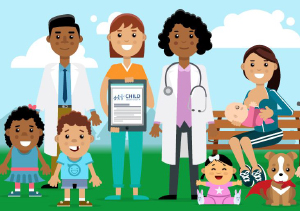Discoveries for life
The faces of health research 2020
| Title |
|---|
 No more “wait and see”: The Language Use Inventory provides a standardized measure to assess early language development in 2- and 3-year-oldsEarly identification of language disorders crucial for early intervention to begin prior to the start of school Dr. Daniela O’Neill A parent wonders, “My toddler isn’t talking, should I worry?” Language disorder comprises the largest disability group among preschool-aged children, affecting 7% of children. In North America, this means about 1.6 million children a year will experience language difficulties requiring early intervention to avoid severe, long-term consequences. Identifying language disorders before 4 years of age is crucial and relies on the availability of empirically-validated and psychometrically-strong assessments. The Language Use Inventory (LUI) is a standardized 20-minute questionnaire completed by a parent or guardian of a child between 18 and 47 months of age, with norms based on over 3500 Canadian children. The LUI allows a speech-language or health professional to provide a parent with an evidence-based answer to where their child stands in terms of their language development relative to other children of the same age in months. This answer can be used to decide whether to further monitor or begin intervention with the child. The LUI can be administered fully online, allowing timely assessment for families in more remote areas or when telepractice becomes necessary (as with Covid-19). The LUI questionnaire is used globally, with many different clinical groups of children (e.g., autistic; deaf; hard-of-hearing) and over 15 translations are underway. Further reading: Twitter: @daniela_oneill |
 A sacred path: Helping Indigenous women face pregnancy in the northDr. Patricia Gregory In northern Manitoba, one out of three pregnant women do not receive adequate prenatal care. Indigenous women in particular experience the greatest health inequities, due to transitions between jurisdictions and healthcare systems. It is also hard for them to relocate and give birth because they often face transportation and accommodation issues, financial constraints, isolation from family, poor communication, and weak referral links. The pregnancy period, which includes a child’s first year of life, is a crucial time to promote health because it will last across a person’s lifespan. To address these inequities, healthcare providers and Indigenous community leaders co-designed a northern pregnancy collective impact network that consists of families, grandmothers, service providers, and policy makers. Along with Indigenous system navigators, this network helps strengthen linkages among Indigenous women. The services provided also respect Indigenous beliefs, and are mindful of issues faced by Indigenous Peoples. As a culturally safe care and shared decision-making process that offers training and empowerment to participants, this is also the first health system intervention to improve transitions in care during pregnancy and maternal child outcomes for Indigenous women in the north. Further reading: Twitter: @pgregory3 |
Improving Medication Prescribing-Related Outcomes for Vulnerable Elderly in Transitions (IMPROVE-IT)Dr. Anne Holbrook Transitions in and out of hospitals are periods of high-risk for patient safety. Many of these patients are seniors who can experience serious adverse medication reactions. Ensuring medication safety requires clinical expertise, excellent communication, and systems expert support. St. Joseph’s Healthcare Hamilton (SJHH) has created an innovative environment for both clinical care and research through its implementation of the electronic health record system, EPIC - Dovetale. SJHH is also one of a handful of hospitals in North America with a Clinical Pharmacology & Toxicology consult service led by physician specialists who are experts in managing high-risk medication. For this project, our Improving Medication Prescribing-Related Outcomes for Vulnerable Elderly in Transitions team will use Dovetale to identify high-risk patients, and then notify the clinical pharmacology team through the inter-professional workload documentation and communication tool. The team will complete a consult with patients through an intervention group that includes the identification of priorities for prescribing medication, steps needed to start a care plan, the development of a detailed discharge medication reconciliation, possession of circle-of-care communication, and use of virtual visits with patients after their hospital discharge. We will start recruiting participants in early 2020, and then use results of the pilot to determine whether a full-scale clinical trial needs to be implemented. Further reading:
|
 Improving the quality of information exchanged between physicians during patient transitions from the intensive care unitDr. Jeanna Parsons Leigh While in hospital, critically ill patients often experience a change in location for care, as well modifications to the health care team members who are taking care of them. Physicians prepare written snapshots of a patient’s ICU stay (i.e. transition summaries) to help prevent communication breaks between ‘sending’ and ‘receiving’ teams when patients move to another unit in the hospital. Unfortunately, commonly used summaries (such as handwritten notes or dictation) are frequently incomplete, and decrease their overall value for seamless patient care. Our team is working to improve the quality of these ICU transition summaries by introducing an electronic tool of clinical information for use in Calgary hospitals. This standardized tool will automate and structure essential content, permitting ICU physicians to create a ‘living’ document that can be edited up to the point of patient transfer. This will ensure that physicians who take over a patient’s care have immediate and up-to-date information. The data that we collect will permit us to examine the impact of the ICU tool on delivering complete and timely information, reducing adverse patient outcomes, and satisfying physicians. Our results will directly inform the implementation of similar tools in other Canadian hospitals. Further reading:
Twitter: @JParsonsLeigh |
 New medical technology will improve transitions to home care for childrenAn evaluation of the connected care program Dr. Reshma Amin and Dr. Julia Orkin Children with medical complexity (CMC) are considered the most fragile subset of children who have special health care needs. They often require high health care resources, and rely on parental caregivers. CMC also experience multiple transitions in care within and across health sectors due to changing needs. Our research focuses on improving the health care trajectories for these medically fragile children. We co-developed the Connected Care Program in partnership with families as a multicomponent intervention tool that includes personalized technology, bundled transition to home intervention, and 24/7 virtual homecare nursing support that will lead to improved hospital-to-home transition of patients. Transitions in Care funding will help us conduct a prospective cohort study with an embedded health economic and qualitative analysis that will improve care for our medically fragile patients and their families. Further reading: Twitter: @DrReshmaAmin, @julia_orkin |
 Can a baby’s gut bacteria influence childhood health?3,500 Canadian kids and their families are helping scientists find the answer CHILD Cohort Study Since 2008, nearly 3,500 Canadian kids and their parents have been participating in the exciting CHILD Cohort Study (CHILD). CHILD is a large Canadian research project that is figuring out how the human microbiome—the universe of bacteria and other tiny organisms that live in and on our bodies—influences allergies, asthma, obesity, and everyday health and wellbeing of children. CHILD research has discovered that an infant’s gut microbiome can be altered by many factors, including the way a baby is born (C-section or vaginal delivery); what a baby is fed (breastmilk or formula); and whether a baby is exposed to antibiotics, furry pets or household cleaning products. CHILD has also determined that babies with low levels of four specific gut bacteria in their first three months of life are more likely to develop asthma. CHILD’s animated video takes us viewers on a journey into the fascinating world of a baby’s gut microbiome and explains how these discoveries are helping parents, professionals and communities understand a healthy baby’s gut so that problems can be prevented in the future. Further reading:
Twitter: @CHILDSTUDY, @AllerGen_NCE |
 When and why does physical activity participation change throughout the life course?Dr. Mathieu Bélanger About 90% of Canadian youth are not meeting physical activity recommendations. Transitions from childhood to adolescence and from adolescence to adulthood are often characterized by a marked decline in sport and physical activity participation. Our research is devoted to developing new knowledge that will help improve, test and implement better interventions to help prevent physical inactivity – which can lead to chronic disease and mortality in Canada. The Monitoring Activities of Teenagers to Comprehend their Habits (MATCH) study followed nearly 1,000 children for eight years, from ages 10 to 18. It led to the development of a better understanding of the natural course of sport and physical activity participation thanks to important life transitions and identified key determinants of participation that involved various motives (such as psychological or environmental factors, behaviours, or life events). MATCH also clarified relationships between physical activity and the development of body-related emotions, mental health, and quality of life. Through an exhaustive knowledge exchange strategy, including collaborations with a variety of knowledge users, the study results are currently influencing policies and practices. Our group also works on the Healthy Start-Départ Santé intervention, which we tested in a 3-year randomized control trial involving over 700 participants. This multi-sectoral intervention proved to be both effective and efficient in improving health-related behaviours in early childhood, and was adopted as a requirement for certification of early-years educators in New Brunswick. Further reading:
|
 Go green, travel cleanPromoting the environmental and health benefits of active travel modes will benefit Canadian schoolchildren Dr. Jason Gilliland Physical activity is important for good health and well-being. It is recommended that children get at least 60 minutes of heart-pumping physical activity per day. An easy way for children to do this is using active modes of travel, such as walking or wheeling (e.g., bikes, scooters, or rollerblades) to and from school. Our novel community-based research program is trying to motivate more children to walk and wheel to school by working closely with children, parents, schools, and community groups. Our approach involves surveying students and parents, and then providing evidence back to the school regarding specific barriers that exist for each school. We use this evidence to help local Active & Safe Routes to School Partnerships develop interventions that will help families choose effective travel routes. Ultimately, this work is helping: 1) increase children’s physical activity levels, 2) decrease the number of cars around school zones to improve local air quality, and 3) create healthy habits among children that will have a positive impact their long-term health and well-being. Further reading:
Twitter: @westernprof; @TheHEALab; @ELMO_ASRTS |
 Understanding the neighbourhood care modelFlexible and local models of integrated care can support healthy communities Dr. Jay Shaw Navigating a variety of health and social services can be extremely difficult for individuals and their families - especially when this involves services delivered by multiple agencies across provincial health care systems and municipal social services. In Ontario, many populations have increasing complex health and social care needs that require systems that can support access to care. Integrated care is an approach intended to enhance the care a person receives from a variety of health and social care service agencies. The Neighbourhood Care Model is a flexible and innovative integrated care project that is designed to respond to these needs in neighbourhoods across the city of Toronto. The model’s primary focus is to build stronger collaboration between home health care, community support services, and community housing so that people with complex health and social needs will be served. Our research seeks to understand the linkages between home health care and community support services, as well as how social determinants of health can have an impact on peoples’ access to these services. This research aligns with international research priorities that evaluate how integrated care models will foster future developments in research, and policy and practice, and benefit the community sector and people with complex needs. Further reading:
Twitter: @jayshaw29 |
 Uncomplicated access, seamless transitions, and continuous careDeveloping and evaluating interventions that support transitions in youth mental health care Dr. Kristin Cleverley Research has shown that as many as 50% of youth move away from mental health services during transitions in mental health care. However, we know little about how the transition experience has an impact on young people or their facilitators, particularly within the Canadian context. Additionally, there is no definition of what a successful transition looks like nor consensus among experts about the core components of interventions and programs to improve continuity of mental health care for youth. In order to address this lack of information, the Cleverley lab has led a scoping review to identify core components of successful child- to adult- mental health care transitions. Then, using a Delphi methodology, three panels composed of youth, caregivers, and service providers provided detailed feedback on these transition components to identify which components were most important and feasible in practice settings. The final list of core components could guide the development of future youth mental health transition interventions and evaluation. Building on the core components, we will now develop a toolkit and evaluate a care navigator intervention. Further reading:
Twitter: @clevkristin |
 Staying active is good for all ages!Website shows how you can get active, stay safe, and prevent injuries Dr. Ian Pike and Dr. Shelina Babul Each year in British Columbia, an average of 900 children and teens are hospitalized due to sports-related injuries. Active & Safe Central (A&S) is an evidence-based website giving parents, kids, coaches, and teachers easy access to injury prevention information for over 50 popular sports and recreational activities, including soccer, volleyball, ice hockey, gymnastics, hiking, kayaking, and snowboarding. A team of researchers across Canada gathered the latest evidence and summarized information for all of the sports and recreational activities featured on the website. A&S has common injuries, risk factors, and strategies for preventing injuries, organized by activity. Four videos were created to supplement the information on the website; the video on Physical Literacy received a Special Commendation in the 2019 IHDCYH Talks Video Competition. Physical activity is important for a healthy lifestyle—but having strong physical literacy not only motivates people to lead active lives, but also reduce their risk of injury. Further reading:
Twitter: @bcirpu |
 Ingredients to healthy, happy children and youthWhy sufficient physical activity, limited screen time, and adequate sleep matter! Dr. Michelle Guerrero Statistics show that many Canadian children and youth are not meeting the recommended movement behaviour guidelines of 60 minutes per day of moderate-to-vigorous physical activity. Instead, they are spending more than 2 hours per day in recreational screen time, and are receiving either 9-11 hours of sleep (ages 5-13) or 8-10 hours per night (ages 14-17). These statistics are not encouraging because a growing body of evidence shows that combinations of sufficient physical activity, limited digital-media use, and adequate sleep are associated with various positive health outcomes. My overall research program is focused on understanding physical, mental, and cognitive benefits and consequences of children and youth’s movement behaviours, and how various factors can promote this activity. Specific areas of research focus include: (1) identifying innovative ways to measure digital media use, and (2) exploring the psychological health impacts of measured digital media use. Further reading:
Twitter: @guerrero_md, @Haloresearch |
 There may be a time and a place, but is pregnancy the one?Evaluating the trends, determinants and impacts on mother and child of cannabis exposure during pregnancy and lactation Dr. Daniel Corsi Even before legalization, the use of cannabis increased in Canada, including among new and expectant parents. Since scientific literature has been inconclusive, it remains difficult to know whether exposure to the drug in utero and in early life may affect short- and long-term well-being of children and their families. Recent research by our group and others suggests that exposure to cannabis during pregnancy may lead to poor birth outcomes and behavioural challenges in later life. However, newer, high-quality data are needed to help us better understand the potential risks to mothers and their infants. Our team is also working with new and expectant Canadian parents, as well as their healthcare providers and policymakers, to ensure that relevant concerns regarding cannabis use are addressed in pregnancy for Canadians. These questions include:
The goal of our research program is to use up-to-date data and appropriate, evidence-based resources regarding decision-making and patient care. Further reading:
Twitter: @OMNI_Obstetrics, @CHEOhospital, @OttawaHospital |
 Youth VoicesTheir Lives and Experiences Living with an Anxiety Disorder Dr. Roberta L. Woodgate Anxiety disorders are the most common mental health problem in young people. Although there is a growing amount of research focusing on anxiety in children and adolescents, this research often fails to include the experiences of living with anxiety as a young person, including their thoughts, feelings and perspectives. Dr. Roberta L. Woodgate and her team at University of Manitoba, developed a CIHR-funded project entitled “Youth Voices: Their Lives and Experiences of Living with an Anxiety Disorder” to address this problem. Through in-depth interviews, 58 youth (between ages 10 and 22) and parents shared experiences. Every word you hear and animation presented is taken directly from the interviews with young people. This series documents the breadth to which anxiety disorder affects them, so that others can develop an understanding of its impact. Further reading:
Twitter: @WoodgateRoberta, @UM_RadyFHS, @Umanitoba Instagram: ShareYourFeels |
 I can talk!Technology gives children and youth who cannot speak a voice, and enables an assessment of language comprehension Ms. Jael Bootsma Imagine living your life without a voice. You would not be able to order your favorite drink, ask questions at school, or tell family members that you love them. Communication is the essence of being human: to be included, understood and taken seriously. Communication helps children and youth develop, and is a key for everyone’s mental health and integration into society. It is hard to know what a person understands in a conversation if they cannot speak themselves. Researchers and clinicians at McMaster University are evaluating whether the Computer-Based instrument for Low motor Language Testing (C-BiLLT), which was developed in the Netherlands, can be adapted into a tool for English-speaking children. This would help determine language comprehension levels in children who have severe motor impairments and are non-verbal. C-BiLLT would also set therapy goals that reflect the child's skills, so that alternative communication systems can be used to optimize the child's ability to learn, develop and participate in daily life and classroom activities. Further reading:
Twitter: @BootsmaJael, @canchild_ca |
 Partnering For PainPartnering with patients, families, healthcare providers, and researchers to co-produce the future of pediatric chronic pain research and care Dr. Katie Birnie Approximately 1 to 3 million Canadian children and teens live in chronic pain. This can prevent them from being active, sleeping, going to school, and being in relationships with friends and family. Children with chronic pain, and their families, are experts on what it’s like to live with pain. Until now, research has not asked them about issues that matter most to them. Our national Partnering for Pain team engaged hundreds of Canadian youth, families, and clinicians in a rigorous James Lind Alliance Priority Setting Partnership to identify the top priorities for pediatric chronic pain research and care. The final top 10 priorities address pediatric chronic pain prevention, impact and treatment, as well as delivery, access and coordination of care. This will help ensure that future research into pediatric chronic pain focuses on what is most important to people who will benefit from it in their everyday lives. Further reading:
Twitter: @katiebirnie |
 What works for whom, how, and why?A Realist Evaluation of the Telehealth Heart Failure Disease Management (HFDM) Program Saleema Allana Heart failure (HF) is the most burdensome and costly disease for seniors in Canada. Its symptoms (difficulty breathing, fatigue, and swollen extremities) have a negative aspect on all areas of life. Heart Failure Disease Management Interventions (HFDMIs) enhance self-care and reduce hospital readmissions through patient education, optimization of medical treatment, psychosocial support, and improved access to care. Over the last two decades, telehealth interventions have been widely applied in the context of HF disease management. Telehealth refers to the use of information and communication technology to deliver health care, so as to increase access, improve outcomes, and reduce costs. These telehealth interventions are complex (involving an interplay of components, underlying mechanisms, and contexts), but often poorly explained and badly understood. These interventions then require a sophisticated analysis from a realist perspective, to identify the contexts and the underlying mechanisms that affect outcomes. This realist evaluation aims to identify the contexts and the underlying mechanisms that make a telehealth HFDMI work. This will be the first realist evaluation of a telehealth HFDMI, which will seek to identify the nuances of what works, for whom, and how?, and thus will open avenues to allow these interventions to benefit patients with heart failure. Further reading:
|
 From ED to EPI: Connecting young people with psychosis to early intervention servicesDr. Nicole Kozloff Many young people with psychosis do not receive helpful community-based care – even when they go to the emergency departments (EDs) of hospitals. At the Centre for Addiction and Mental Health, our researchers are studying what gets in the way of youth accessing and engaging with evidence-based early psychosis intervention (EPI) services, and how to address these barriers. Based on preliminary research, we think text messages that include reminders, psychoeducation, and check-ins, with input from youth and families, can help more young people connect with outpatient care from the ED. With a randomized controlled trial, half of the participants will be assigned to an intervention group that receives the text messages, while the other half will receive standard care. Young people who receive the intervention will complete a brief Web-based survey regarding their experience, and a subgroup will take part in interviews. We will then assess patient outcomes in electronic health records and provincial administrative databases, and perform an economic analysis to see if the text messages are cost-effective. If so, simple, technology-based interventions such as these may help more young people with psychosis take their first steps towards treatment and recovery. Further reading:
Twitter: @nicole_kozloff |
 Developing better health service interventions for youth living with diabetesImproving the transition of care for pediatric and adult diabetes patients Dr. Rayzel Shulman As they age, people living with type 1 diabetes (T1D) often have a hard time caring for themselves and maintaining healthy relationships with others. This is because they do not consistently experience best practices in diabetes transition care. My research develops and evaluates novel ways to improve health outcomes and the quality of care for youth living with diabetes as they transition to adulthood by leveraging population-level administrative datasets that inform health system change. In collaboration with patients and providers, we are developing and testing a KiT (Keeping in Touch) trial that uses a text algorithm to deliver just-in-time personalized transition education that will help young adults transition to adult care. Through our Bridging the Gap study, we are also evaluating an audit and feedback-based intervention in pediatric diabetes clinics to encourage transition-related quality improvement initiatives. In the T1ME trial (led by Dr. Gillian Booth), we are testing a virtual care model that will reduce the burden of T1D care and improve management of the disease. Further reading:
Twitter: @rayzel_shulman |
 Youth can prevent concussions if they play safeDr. Carolyn Emery In the 2014–15 ice hockey season, 10-20% of young hockey players (aged 13-17) in Canadian leagues suffered at least one concussion. Symptoms of this brain injury include headaches, dizziness, neck pain, memory problems, and depression. Dr. Carolyn Emery, from the University of Calgary Sport Injury Prevention Research Centre, has been examining ways to prevent, detect, and manage concussions. Part of her research involves talking to former hockey players who suffered the brain injury when they were young – and, as a result, cannot play the game now. Dr. Emery has determined that youth would not face these concussions if coaches enforced proper rules during the game that included no body checking. Dr. Emery’s research team is also studying children’s neurological development using a variety of new diagnostic tools that identify specific impairments associated with concussions (including tests of balance, neck function, vision, memory, nutrition, social interaction, and growth factors). This will help researchers and clinicians pinpoint when concussions occur, target those who need treatment, and measure recovery. Dr. Emery’s research results will reduce the negative effects of sport on the well-being of young athletes. Further reading: |
 The OPAC Corrections StudyEvaluating whether community transition teams can further help people with opioid use disorder Dr. Seonaid Nolan After release from a correctional facility, individuals can feel vulnerable as they try to re-immerse themselves into communities and access health care services. If they do not receive proper treatment, some of them are at high risk to relapse into substance use, recidivism and a host of other negative outcomes. In order to address this problem, the Provincial Health Services Authority and the British Columbia (BC) Mental Health & Substance Use Services have recently implemented the use of community transition teams (CTTs) that help individuals with opioid use disorders face their addiction after release from a correctional facility in BC. CTTs adopt a client-centred approach to care, while case managers work closely with a client to support them in reaching their treatment goals following release. No formal evaluation of CTTs currently exists to determine the impact of this evidence-based treatment approach on resulting health outcomes or service utilization among this high-risk patient population. Our study will invite individuals with opioid use to complete a one-time questionnaire and consent to annual database linkage over a five-year follow-up period. This will provide a unique opportunity for longitudinal tracking of relevant health outcomes associated with the use of CTTs at a provincial level, as well identifying and responding to implementation gaps that may be preventing its overall success. Further reading: |
 Partnership that improves the care of patients after ICUDr. Kirsten Fiest Patients in the intensive care unit (ICU) are very vulnerable and can often face new medical problems or treatments once they leave the hospital. Dr. Fiest’s team of patients, family caregivers, clinicians, knowledge users, and researchers is working on three novel research projects at the Calgary Critical Care Research Network that will help family members and patients better control their overall well-being. In the first project, health care teams will invite family members of patients in the ICU to learn about the condition, progress, and proposed plan of care for the patient. In the second project, family members will participate in activities that can help them prevent, detect, and manage cases of delirium that occur in the ICU. In the third project, patients and family members will learn about steps they can take to maintain good health when the patient is discharged from the ICU. To find out more about Dr. Fiest’s research accomplishments with patients and their families, and to receive updates on the overall development of these projects, please visit the Calgary Critical Care Research Network’s website Further reading: Twitter: @kmfiest |
 Who’s caring for the caregiver?Caring for the Caregiver: An Examination of Service Use Across the Illness Trajectory Kristina Marie Kokorelias An understanding of how to best care for persons with Alzheimer’s disease is among one of the most important challenges for health service researchers. With an aging population and increase in dementia prevalence, this need is growing. Family caregivers play a central role in supporting individuals with dementia from symptom onset to death. Caregiving is not static and changes across the illness trajectory. Understanding these caregiving phases allows the provision of timely supports and services to maximize caregiver and care recipient quality of life The goal of my research is to determine: 1) caregiver-identified phases across the care and illness trajectory; 2) caregivers’ health and social service needs corresponding to phases of care; 3) decision-making processes regarding health and social service utilization corresponding to phases of care, especially potential barriers and enablers to service use; and 4) influence of the relationship of the caregiver to the care recipient on caregiving phases, service needs, and decision making about service utilization. Findings have the potential to help design, evaluate, and translate new and innovative community-based interventions to improve access to health care and caregiver support, quality of life, and health outcomes in this population. Further reading: Twitter: @kmkokorelias |
- Date modified:
